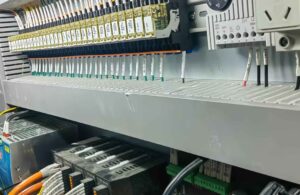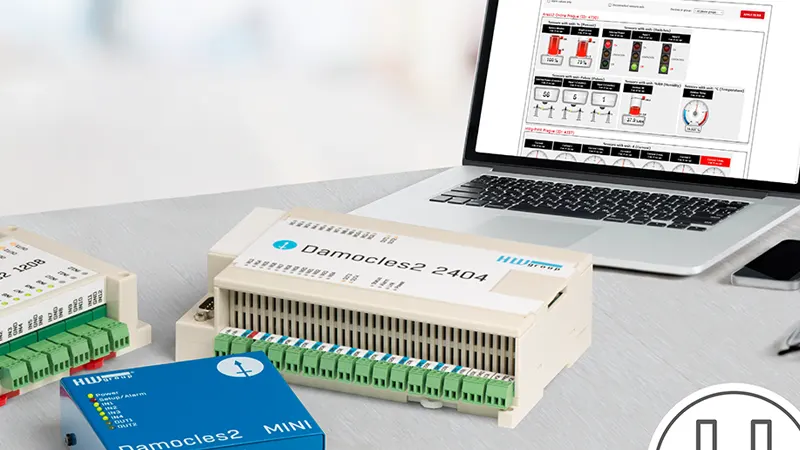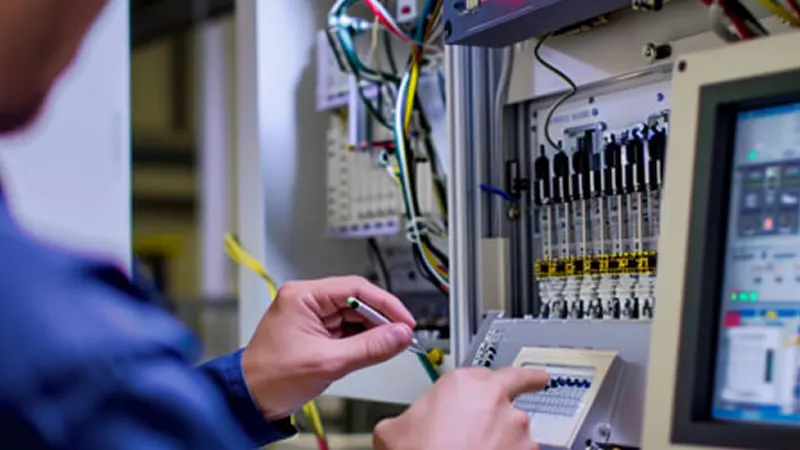Ethernet ve Modbus: Fabrikanıza Hangisi En İyi Gücü Sağlar?
Ethernet, fabrika ağları için standart iletişim protokolü haline geldi. Bu arada, Modbus proses otomasyonu ve SCADA sistemlerinde yaygın olarak kullanılmaya devam ediyor. Projeniz için doğru seçimi yapmak adına aralarındaki farkları anlamak çok önemlidir.
İçindekiler
Ethernet Nedir?
Ethernet, öncelikle Yerel Alan Ağları (LAN) ve Geniş Alan Ağları (WAN) oluşturmak için kullanılan bir ağ protokolüdür. 1983'te IEEE tarafından 802.3 olarak standartlaştırılmış ve o zamandan beri dünya çapında en yaygın olarak benimsenen iletişim teknolojilerinden biri haline gelmiştir.
Ethernet'in Temel Özellikleri ve İşlevleri
- Yüksek İletim Hızı: Ethernet, 10 Mbps'den 1 Gbps'ye kadar hızları destekler; modern sürümleri 10 Gbps'ye (10GbE) kadar ulaşır ve bu da onu veri merkezleri ve bulut bilişim gibi yüksek veri talebi olan ortamlar için ideal hale getirir.
- Açık Standart: Ethernet, TCP/IP protokolleriyle kusursuz bir şekilde entegre olduğundan BT ve endüstriyel otomasyon sistemlerini bağlamak için mükemmel bir seçimdir.
- Çeşitli Topolojiler İçin Destek: Ethernet, yıldız, halka ve veri yolu yapılandırmalarına izin vererek farklı ağ ortamları ve cihazları için esnek olmasını sağlar.
- Kolay Dağıtım ve Genişletme: Ethernet, Cat5e, Cat6 ve fiber optik gibi yaygın kabloları kullanır, kurulumu basitleştirir ve maliyetleri azaltır. Ayrıca daha kolay ağ genişlemesi için kablosuz bağlantıları da destekler.
Bu özellikleri sayesinde Ethernet, özellikle veri yoğun ortamlarda, hem endüstriyel hem de ticari ağların vazgeçilmezi haline gelmiştir.
Ethernet Endüstriyel Ortamlarda Neden Popülerdir?
EtherNet/IP gibi Endüstriyel Ethernet, geleneksel Ethernet'i gerçek zamanlı veri iletimi ve senkronizasyon yetenekleriyle genişletir. Bu, hareket kontrolü ve süreç senkronizasyonu gibi hassas kontrol ve izleme gerektiren uygulamalar için çok önemlidir.
EtherNet/IP, farklı satıcılardan gelen cihazlar arasında sorunsuz iletişimi garantilemek için Ortak Endüstriyel Protokol'ü (CIP) kullanır, entegrasyon maliyetlerini ve karmaşıklığı azaltır. Ayrıca, Ethernet'in yüksek bant genişliği ve esnekliği, hem gerçek zamanlı veri izlemeyi hem de BT sistemleriyle sorunsuz entegrasyonu destekleyerek onu Endüstriyel IoT (IIoT) uygulamaları için uygun hale getirir.
Zaman Duyarlı Ağ (TSN) gibi gelişmelerle Ethernet artık düşük gecikmeli ve kesin iletişim sunarak kritik operasyonlar için sistem kararlılığı ve güvenilirliğini garanti altına alabilir. Sonuç olarak, endüstriyel Ethernet fabrikaları daha yüksek verimlilik ve daha akıllı operasyonlar için modernize etmede önemli bir rol oynar.
Modbus Nedir?
Modbus, 1979 yılında Modicon tarafından Programlanabilir Mantık Denetleyicileri (PLC'ler) ve diğer cihazlar. Basitliği ve uyumluluğu ile bilinen Modbus, endüstriyel otomasyon için vazgeçilmez bir protokol olmaya devam ediyor.
Modbus'un Temel Avantajları
- Çoklu İletişim Ortamlarını Destekler: Modbus, RS-232, RS-485 ve Ethernet üzerinden veri iletebilir ve bu da onu çeşitli uygulamalar için çok yönlü hale getirir.
- Basit ve Kullanımı Kolay:Master-slave iletişim modeli, basit dağıtım sağlayarak küçük ölçekli kontrol sistemleri için idealdir.
- Açık Protokol:Açık bir standart olan Modbus, farklı üreticilere ait cihazların sorunsuz bir şekilde iletişim kurmasını sağlayarak ekipman seçeneklerini genişletir ve sistem entegrasyon maliyetlerini azaltır.
Modbus, güvenilirliği nedeniyle proses otomasyonu ve izleme için SCADA sistemlerinde bir standart olmaya devam ediyor. Açık yapısı, Modbus TCP/IP aracılığıyla yaygın olarak kabul görmesini ve modern Ethernet altyapılarına kolayca entegre edilmesini sağlıyor.
Modbus için Genel Kullanım Örnekleri
Modbus, endüstriyel proseslerde veri izleme ve toplama için SCADA sistemlerinde sıklıkla kullanılır. Sıcaklık ve nem ölçümleri gibi temel bilgileri merkezi bir kontrolöre iletmek için cihazlara ortak bir dil sağlar.
Modbus'un çok yönlülüğü onu sadece endüstriyel otomasyon için değil aynı zamanda uzaktan izleme, teşhis, enerji yönetimi ve ulaşım sistemleri için de uygun hale getirir.
Ethernet mi Modbus mu: Hangisini Seçmelisiniz?
Veri İletim İhtiyaçları ve Gerçek Zamanlı Performans
Sisteminiz çok eksenli hareket kontrol sistemleri gibi yüksek hızlı veri transferi ve gerçek zamanlı kontrol gerektiriyorsa Ethernet'i seçin.Sistem Karmaşıklığı ve Cihaz Sayısı
Daha az cihaza sahip basit ağlar için Modbus uygun fiyatlı ve dağıtımı kolay bir çözüm sunuyor.Uyumluluk ve Entegrasyon
Birden fazla satıcı cihazıyla birlikte çalışabilirliğe ve BT sistemleriyle sorunsuz entegrasyona ihtiyacınız varsa, Ethernet (özellikle EtherNet/IP) daha iyi bir seçimdir.Çevre ve İletim Mesafesi
Ethernet, kararlı, kablolu ortamlarda iyi çalışır. Ancak, RS-485 üzerinden Modbus RTU, elektromanyetik girişimin olduğu ortamlar gibi uzun mesafeler ve zorlu koşullar için daha iyidir.Maliyet ve Ölçeklenebilirlik
Ethernet, büyük ölçekli, genişletilebilir sistemler için idealdir, ancak daha yüksek başlangıç maliyetleri vardır. Buna karşılık, Modbus daha küçük veya eski sistemler için düşük maliyetli bir seçenek sunar.
Modbus ve Ethernet hakkında Sıkça Sorulan Sorular
1. Ethernet Modbus'tan daha mı hızlıdır?
Evet, Ethernet 1 Gbps'ye kadar veya daha fazlasını destekleyerek çok daha yüksek iletim hızları sunarken, Modbus RTU genellikle 9600 ile 115200 bps arasında çalışır. Ethernet, yüksek veri çıkışı ve gerçek zamanlı yanıtlar gerektiren uygulamalar için daha uygundur.
2. Modbus seri ile Ethernet arasındaki fark nedir?
Modbus seri (örneğin, RS-232, RS-485) kısa mesafeli bağlantılar ve daha düşük veri hızları için seri iletişim kullanır. Ethernet, TCP/IP ağları aracılığıyla daha yüksek hızları ve daha uzun mesafeleri destekler ve bu da onu uzaktan izleme ve karmaşık ağlar için daha iyi hale getirir.
3. Modbus için Ethernet kabloları kullanılabilir mi?
Evet, Modbus TCP/IP Ethernet ağları üzerinden çalışır ve Ethernet kablolarının Modbus uyumlu cihazları bağlamasına olanak tanır. Bu kombinasyon Modbus'un basitliğini Ethernet'in hızı ve esnekliğiyle birleştirerek uzaktan izleme gerektiren endüstriyel otomasyon sistemleri için idealdir.
4. Ethernet ile Profibus arasındaki fark nedir?
Ethernet, BT ve endüstriyel ortamlarda kullanılan, yüksek hızlı veri aktarımını ve gerçek zamanlı kontrolü destekleyen açık bir standarttır. Öte yandan Profibus, süreç otomasyonuna odaklanan uzmanlaşmış bir saha veri yoludur. Profibus daha iyi kesinlik sunarken, Ethernet daha esnektir ve modern BT ve IIoT sistemleriyle entegrasyonu daha kolaydır.
Projelerinize yepyeni, orijinal Omron, Mitsubishi, Schneider PLC'lerle güç katın - stokta, hemen kullanıma hazır!
Çözüm
Özetle, uygulamanız yüksek hızlı ve gerçek zamanlı veri iletimi gerektiriyorsa, Ethernet (özellikle EtherNet/IP) sizin için en iyi seçenektir. Daha basit sensör ağları ve kontrol sistemleri için Modbus güvenilir ve uygun maliyetli bir çözüm olmaya devam etmektedir.
Hangi protokolü seçerseniz seçin, tedarikçinizin hızlı teslimatla yeni, orijinal ekipman sağlamasını sağlamak önemlidir. Kwoco'da, zamanında teslimatın ve ürün kalitesinin müşteri güvenini oluşturmanın anahtarı olduğunu anlıyoruz. Sorularınız mı var? Bana ulaşmaktan çekinmeyin satış@kwoco-plc.com.
Bize Ulaşın
Bu forma adınızı, e-posta adresinizi ve sorunuzun kısa bir açıklamasını girmeniz yeterlidir. 24 saat içinde sizinle iletişime geçeceğiz.
Bu Konuları da İlginizi Çekebilir

Endüktif Sensörler: Endüktif Yakınlık Sensörlerinin Çalışma Prensibinin Gizemini Çözmek
Bu makale, endüktif sensörlerin büyüleyici dünyasına dalarak, nasıl çalıştıklarını, çeşitli türlerini ve endüstriyel otomasyondaki geniş kapsamlı uygulamalarını açıklıyor. İster deneyimli bir mühendis olun, ister bu cihazlar hakkında meraklı olun, bu kapsamlı rehber, çok sayıda endüstriye güç veren teknoloji hakkında değerli bilgiler sunacak ve modern algılama çözümlerinin inceliklerini anlamak isteyen herkes için değerli bir okuma haline getirecektir.

Endüstriyel Otomasyonda Fotoelektrik Sensör Türlerine İlişkin Kapsamlı Kılavuz
Bu makale, fotoelektrik sensörlerin büyüleyici dünyasına dalarak endüstriyel otomasyondaki çeşitli türlerini, işlevlerini ve uygulamalarını inceliyor. Bu dedektörlerin üretim süreçlerini nasıl dönüştürdüğü, verimliliği nasıl artırdığı ve hassasiyeti nasıl sağladığı konusunda kapsamlı bir anlayış sağlamayı amaçlıyoruz. Makine ve ekipman sektöründe, üretimde veya fabrika çözümleri sağlamada yer alıyorsanız, bu makale operasyonlarınız için fotoelektrik sensör teknolojisinden yararlanma konusunda değerli içgörüler sunuyor ve daha fazla okumanın otomasyon stratejilerinizi optimize etmek için size neden bilgi sağlayacağını açıklıyor.

En İyi PLC Üreticileri: Programlanabilir Mantık Denetleyicilerinde En İyi Markalar
Programlanabilir Mantık Denetleyicileri (PLC'ler), modern endüstriyel otomasyonun kalbidir. Makineleri, süreçleri ve fabrika montaj hatlarını kontrol ederek operasyonları daha verimli ve güvenilir hale getirirler. Bu makale, dünya çapında endüstrilere güç veren önde gelen PLC markalarını inceleyerek PLC üreticilerinin dünyasına dalıyor. Otomasyona yeni başlıyor olun veya sistemlerinizi yükseltmek istiyor olun, PLC pazarındaki en iyi oyuncuları anlamak esastır.






